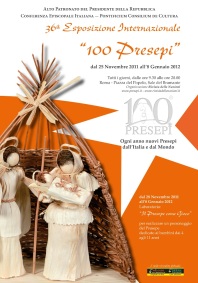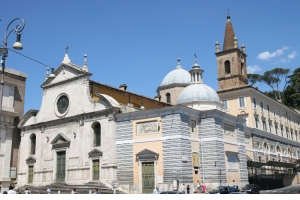An event not to be missed is the exhibition in Rome of 100 cribs at Piazza del Popolo, in progress since November 25 open non-stop from 9:30 to 20:00, 8 January will show up more than 200 cribs made by artists from around the world using a wide variety of materials and foods such as chocolate, corn, caps and buttons. The exhibition is housed in impressive Sale del Bramante, inside the Basilica of Santa Maria del Popolo.
DESCRIPTION
The exhibition is traditionally held under the patronage of the President of the Republic and with the patronage of the Italian Episcopal Conference (CEI), the Senate, the Chamber of Deputies, the President of the Council of Ministers, the Ministry of Heritage and Culture, the Lazio Region, the Province of Rome, the Rome City Council and the National Association of Italian Municipalities.
The name “100 CRIBS” is just a historical reference, as it indicates the number of cribs on display in the first edition.
The cribs, which are completely renewed every year, come from almost all Italian regions and about 25 foreign countries, are works of Italian and foreign artists and craftsmen, collectors, amateurs, students of primary and secondary schools, representatives of cultural associations and engaged in social, state and local authorities and national and foreign museums.
The works are made with materials of the most varied, from coral, silver, porcelains, glass, bronze, ceramics clay, wrought iron, wood, paper mache, materials recovery. But sometimes the cribs are made with chocolate, bread, corn, maize, caps or buttons, shells, seafood, pasta, car candles, pencils and so on.
Sizes range from miniature format as the nativity in bas-relief reproduced in a nut shell, to those at eye level.
The cribs have static or moving environments different from those of classic Neapolitan and Sicilian seventeenth and eighteenth centuries, and nineteenth century Roman futuristic ones expressed in crystals, iron and colored lights or fancy as car engines, televisions, and other carboys.
The cribs and crib figures of the era, from museums and private collections, are works by renowned artists and the founder lived in the past, and come from more traditional crib regions such as Campania, Lazio, Liguria , Apulia, Sicily and abroad.
The exhibition is open continuously from 9:30 to 20:00, from November 25, 2011 at ‘January 8, 2012.
Admission:
Full € 7.00 – € 5.50 reduced
Santa Maria del Popolo is one of the most important buildings of the Roman Renaissance, not only for its architectural features, but also paintings and sculptures that make it a valuablemuseumofRenaissanceart. The church was built over a small chapel built by Pope Paschal II at the expense of the Roman people (hence the name) on the graves of Domizi to chase, according to legend, the spirit of Nero. More likely it was built in gratitude for the conquest ofJerusalem, at the end of the First Crusade. Built in the fifteenth century time of Pope Sixtus IV, was modified in the seventeenth century and is linked to the names of Bramante, Sansovino, Pinturicchio, Mino da Fiesole, Raphael, Caravaggio. Of the latter are the Conversion of St. Paul and the Crucifixion of St. Peter, together with Assumption by Annibale Carracci decorate the Cerasi chapel, to the left of the main altar.
The interior has three naves, a Latin cross plan with vaulted ceilings, sober and proportionate shows the schematic of the Cistercian churches. In the floor there are several tombstones dating from the Middle Ages and the Renaissance. The chapels are filled with funerary monuments and works of art. Among these, the most important is the Chigi Chapel, second left, made a design by Raphael for the banker Agostino Chigi since 1513 and only completed between 1652 and 1656 with the intervention of Gianlorenzo Bernini by Pope Alexander VII Chigi. Raphael created for the chapel of the cartoons for the mosaics of the dome (God the Father and Creator of the heavens of the seven symbols of the sun and planets), performed by Louis Peace in 1516, and the design for the pyramid tombs of Agostino Chigi and his brother Sigismund , performed later by Lorenzetto, Raphael da Montelupo and Bernini with some modifications. Even the statue of Jonah coming out of the whale was made by Lorenzetto a design of Raphael, and Habakkuk and the Angel and Daniel in the lions are the work of Bernini. The altarpiece is the work of Sebastiano del Piombo and Salviati.


Reblogged this on Toward the within….